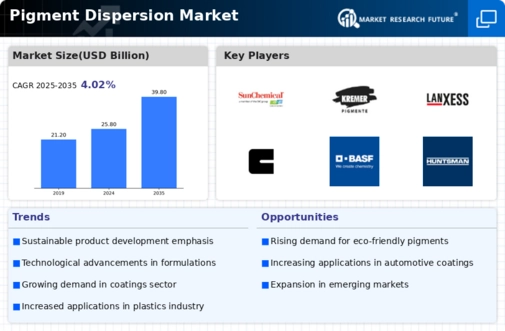Top Industry Leaders in the Pigment Dispersion Market
 Pigment dispersions, the unsung heroes of the color world, breathe life into our surroundings. These meticulously crafted blends of pigments, resins, and solvents transform raw materials into vibrant hues, enriching everything from paints and coatings to plastics and textiles. Understanding the competitive landscape of this dynamic market is crucial for navigating its complexities and seizing potential opportunities.
Pigment dispersions, the unsung heroes of the color world, breathe life into our surroundings. These meticulously crafted blends of pigments, resins, and solvents transform raw materials into vibrant hues, enriching everything from paints and coatings to plastics and textiles. Understanding the competitive landscape of this dynamic market is crucial for navigating its complexities and seizing potential opportunities.
Strategic Strokes in the Palette:
Leading players like BASF SE, Lanxess, and Sun Chemical Corporation employ a range of strategies to dominate the market:
-
Product diversification: Offering a vast array of dispersions for diverse applications, from high-performance coatings to food and cosmetic colorants. -
Technological innovation: Investing in R&D to create dispersions with superior color strength, durability, and environmental sustainability. This includes developing eco-friendly pigments, bio-based resins, and low-VOC solutions. -
Regional expansion: Targeting high-growth markets like Asia Pacific and Latin America by establishing local production facilities and tailoring offerings to regional needs. -
Vertical integration: Gaining control over the supply chain by acquiring raw material suppliers or expanding into downstream applications like paint manufacturing. -
Strategic partnerships: Collaborating with pigment manufacturers, research institutions, and technology startups to accelerate innovation and access new markets and technologies.
Key Factors Dictating Market Share:
Winning in this vibrant market hinges on several critical factors:
-
Product quality and performance: Delivering dispersions with exceptional color consistency, dispersion stability, and compatibility with diverse substrates. -
Cost competitiveness: Balancing high quality with affordability, especially in price-sensitive segments like packaging and industrial coatings. -
Sustainability focus: Demonstrating a commitment to eco-friendly dispersions with reduced environmental impact through low-VOC formulations, bio-based materials, and efficient production processes. -
Regulatory compliance: Ensuring compliance with stringent regulations on pigments, solvents, and environmental standards. -
Customer service and support: Building strong relationships with clients through technical expertise, reliable deliveries, and efficient after-sales support.
Key Players:
PPG Industries Inc. (U.S.)
RPM International Inc. (U.S.)
Akzo Nobel N.V. (The Netherlands)
The Sherwin-Williams Company (U.S.)
Kelly-Moore Paints (U.S.)
BASF SE (Germany)
Clariant (Switzerland)
Dunn-Edwards Corporation (U.S.)
KANSAI PAINT CO., LTD (Japan)
Tikkurila Oyj (Finland)
Recent Developments:
-
October 2023: A major research consortium publishes a study demonstrating the feasibility of using advanced nanomaterials in pigment dispersions to achieve enhanced color vibrancy and durability. -
November 2023: The increasing adoption of digital printing technologies creates a new demand for high-precision pigment dispersions for inkjet inks. -
December 2023: Advancements in recycling technologies lead to the development of closed-loop systems for pigment dispersion waste, paving the way for a more sustainable future for the market.

